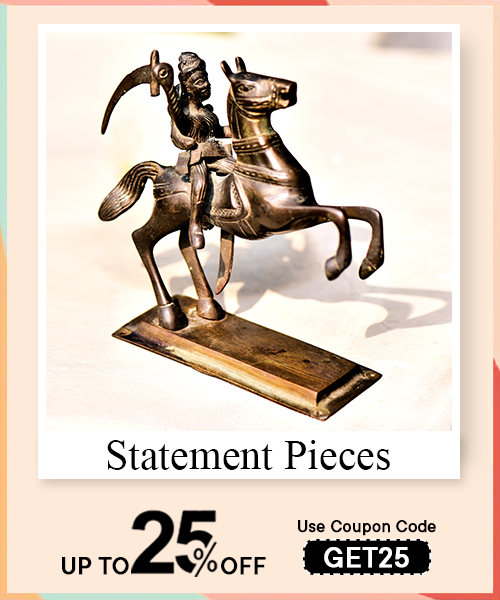Miniature painting is a traditional art form characterized by its small size and intricate details. These artworks are typically created on surfaces like paper, ivory, or wood. Despite their small size, they showcase elaborate designs, vibrant colors, and a high level of precision. Artists use fine brushes and magnifying tools to achieve the level of detail required. Miniature art often represents scenes from mythology, nature, or daily life and is admired for its beauty and craftsmanship. It requires immense patience and skill to create.
Materials used in miniature art include natural pigments, watercolors, and gold leaf. Artists create colors from plants, minerals, and stones to achieve vibrant hues. Brushes are usually made from animal hair, enabling precise strokes. Surfaces like paper, parchment, ivory, and wood are commonly used for traditional miniatures. In modern times, artists may also use synthetic colors and canvas. Each material is chosen carefully to ensure durability and enhance the artwork’s details and overall appearance.
Miniature art stands out for its delicate details, vibrant colors, and the intricate representation of subjects despite its small size. Unlike larger artworks, miniatures demand extraordinary precision and focus. Each piece captures fine details, such as facial expressions, patterns, or textures, which are often magnified to bring out their beauty. The use of handmade colors, fine brushes, and techniques passed down through generations makes it a unique and highly valued form of art. Its themes often reflect history, culture, and tradition.
Miniature painting has its origins in ancient civilizations such as Persia, India, and Europe. In India, it flourished during the Mughal period, with artists creating elaborate depictions of royal life, mythology, and cultural scenes. Persian miniatures influenced Indian art, leading to unique styles like Mughal and Rajput miniatures. In Europe, illuminated manuscripts often featured intricate miniature illustrations. The style spread across regions, evolving with local traditions and techniques, creating a rich and diverse history of miniature art worldwide.
Miniature art explores a variety of themes, including mythology, royal life, nature, and religion. Indian miniatures often depict stories from epics like the Ramayana and Mahabharata or scenes from daily life in royal courts. Nature-inspired themes include animals, landscapes, and floral patterns. Religious subjects are also prominent, with depictions of gods, saints, and spiritual stories. These themes reflect the cultural and historical context of the region, offering a glimpse into the lives, beliefs, and traditions of the past.
Creating miniature painting requires specialized tools. Artists use fine brushes made from animal hair to achieve precision in details. Magnifying glasses or lenses are essential for intricate work. Natural pigments, watercolors, and gold leaf are commonly used to create vibrant colors. Artists also need palettes for mixing colors and knives for scraping errors. Each tool is selected to enhance the artist’s ability to create delicate designs and patterns, which are central to the appeal of miniature art.
- Mughal Miniatures: Known for realistic depictions of royal life, battles, and nature.
- Rajput Miniatures: Emphasize themes of love, devotion, and mythology with bold colors and expressive figures.
- Persian Miniatures: Celebrated for poetic and decorative approaches with fine details and vibrant designs.
- European Miniatures: Often appeared in illuminated manuscripts, showcasing religious and historical scenes.
Miniature art is typically defined by its small size, usually not exceeding 25 square inches. Despite its limited dimensions, the focus is on intricate details rather than the overall size. The goal is to create a visually striking and detailed piece that can be appreciated even when magnified. The small size of the artwork demands precision, patience, and exceptional skill, which is why miniature art is highly regarded by collectors and enthusiasts around the world.
Read More : Stone Painting: A Creative Guide to Painted Rocks and Designs
Miniatures are detailed because they aim to capture complex scenes within a limited space. Artists pay close attention to every element, from facial expressions to background patterns. The use of fine brushes and magnifying tools helps achieve this precision. The focus on details not only enhances the beauty of the piece but also tells a story in a compact format. This dedication to intricacy is what makes miniature art stand out and keeps the tradition alive.
- Parchment: Smooth and durable, ideal for intricate details.
- Ivory: Traditionally used for its fine texture and longevity.
- Wooden Panels: Offers a sturdy surface for detailed work.
- Handmade Paper: Common in Indian miniature traditions.
- Canvas & Synthetic Materials: Used in modern adaptations to replicate traditional surfaces.
The choice of material plays a significant role in preserving the artwork’s vibrancy and ensuring its durability over time.
Miniature painting holds great historical importance as it documents the cultural, religious, and social aspects of different eras. These artworks were often commissioned by royalty to depict their achievements, daily life, or religious devotion. They also served as visual records of historical events, preserving stories for future generations. Through intricate details and vibrant imagery, miniature art reflects the artistic excellence of the time and offers valuable insights into the traditions, beliefs, and lifestyles of ancient civilizations.
Gold leaf is used in miniature art to add richness, elegance, and a sense of luxury. It is often applied to highlight specific details, such as borders, ornaments, or celestial elements. The inclusion of gold creates a striking contrast against vibrant colors, making the artwork visually captivating. Gold leaf also symbolizes wealth and divinity, which aligns with the themes of royalty and spirituality commonly found in miniatures. Its use demonstrates the artist’s craftsmanship and attention to detail.
In traditional miniature art, colors are often prepared from natural sources. Artists use minerals, plants, and stones to create pigments. For example, red might be derived from cinnabar, while green can come from malachite. These raw materials are finely ground, mixed with water or a binding agent, and carefully applied to the artwork. The use of natural pigments ensures vibrant and long-lasting colors. This meticulous process reflects the dedication and skill required to create traditional miniatures.
Miniature art often portrays scenes from everyday life, including activities in royal courts, festivals, and rural settings. These depictions offer a glimpse into the cultural and social dynamics of the time. Artists capture details like clothing, architecture, and interpersonal relationships, bringing the past to life. The artwork serves as a visual record of how people lived, worked, and celebrated, making it an important historical resource. Such portrayals also highlight the diversity and richness of different cultures.

Artists achieve precision in miniature art through the use of fine brushes, steady hands, and magnifying tools. Each stroke is meticulously planned and executed to ensure clarity and detail. The use of high-quality materials, such as smooth surfaces and handmade pigments, further enhances the accuracy of the artwork. Years of practice and mastery of techniques passed down through generations contribute to the artist’s ability to create such intricate designs. This precision is what sets miniature art apart from other forms of visual expression.
Miniature art is distinguished by its small size, intricate details, and focus on precision. Unlike larger art forms that may emphasize bold strokes or expansive compositions, miniatures aim to capture fine details within a compact space. The use of magnifying tools and fine brushes allows artists to achieve a level of detail that is often unmatched. Additionally, miniatures often have a historical or cultural significance, reflecting the traditions and stories of specific regions or eras.
Storytelling is a central element of miniature artwork. These works often depict scenes from mythology, history, and folklore, narrating tales through visual representation. Each element of the artwork, from the characters to the background details, contributes to the story being told. The intricate designs and vibrant colors engage viewers, drawing them into the narrative. Miniatures serve as a medium for preserving cultural heritage and passing down stories through generations, making them a powerful form of visual storytelling.
Illuminated manuscripts are hand-written books adorned with decorative illustrations, often created in the style of miniature art. These illustrations include intricate borders, initials, and scenes that enhance the text’s meaning. Common during the Middle Ages in Europe, illuminated manuscripts often depicted religious stories, historical events, or mythological themes. The fine detailing and vibrant colors used in these manuscripts share similarities with miniature art, making them an important part of its history and evolution.
Read More : Tanjore Painting: A Traditional Indian Art Form with Rich History and Cultural Significance
The Mughal style of miniature art originated in India during the Mughal Empire. Influenced by Persian and Indian traditions, this style is known for its realism, fine detailing, and vibrant colors. Themes often include royal portraits, court scenes, and depictions of nature. Mughal miniatures are celebrated for their intricate designs and use of gold and natural pigments. This style not only highlights artistic excellence but also offers insights into the grandeur and sophistication of the Mughal period.
Miniature art has evolved from traditional hand-painted works to modern interpretations using new techniques and materials. While early miniatures were created on parchment or ivory, contemporary artists use canvas, synthetic pigments, and digital tools. Themes have expanded beyond mythology and history to include modern life and abstract concepts. Despite these changes, the core focus on detail and precision remains the same, ensuring that miniature art continues to captivate and inspire audiences worldwide.
- Fine brushes made from squirrel or camel hair for precision.
- Surfaces like parchment, ivory, or handmade paper for smooth detailing.
- Natural pigments from minerals, plants, and stones mixed with binders.
- Gold and silver leaf for embellishment and richness.
- High-quality materials ensure vibrancy and durability over time.
Persian influence on miniature art is evident in its emphasis on detailed designs, vibrant colors, and storytelling. Persian miniatures often depict scenes from literature, mythology, and royal life, characterized by ornate patterns and intricate details. This style greatly impacted other traditions, such as Mughal miniature art, through cultural exchanges. Persian artists introduced techniques like the use of fine brushes and layered compositions, which became integral to miniature art. Their influence continues to inspire artists worldwide.
Modern artists adapt traditional miniature techniques to contemporary themes and materials. While they maintain the focus on precision and intricate designs, they often use synthetic pigments, digital tools, and new surfaces like canvas or acrylic sheets. Themes have also broadened to include urban landscapes, abstract concepts, and social commentary. These adaptations keep the art form relevant and accessible to modern audiences while preserving its traditional essence. The fusion of old and new makes miniature art timeless.
- Shahnameh of Ferdowsi: A Persian epic adorned with elaborate illustrations.
- Akbarnama: A Mughal manuscript depicting Emperor Akbar’s reign.
- Book of Hours: Illuminated manuscripts from medieval Europe showcasing religious devotion.
These masterpieces are celebrated for their intricate details and artistic innovation, reflecting the cultural and historical contexts of their creation. They remain valuable artifacts in museums and private collections worldwide.
Preserving miniature art is challenging due to its delicate nature and the materials used. Factors like humidity, light exposure, and handling can cause fading, discoloration, or damage. Conservation efforts include storing artworks in climate-controlled environments, using protective frames, and minimizing exposure to direct light. Restoration requires skilled professionals to carefully repair and maintain the original details. These measures ensure that miniature art remains intact for future generations to appreciate.
Religious themes are common in miniature acrylic, reflecting the spiritual beliefs of various cultures. These artworks often depict scenes from sacred texts, rituals, or deities, serving as tools for devotion and education. For example, Christian illuminated manuscripts feature Biblical stories, while Indian miniatures portray Hindu epics like the Ramayana and Mahabharata. The detailed imagery and vibrant colors used in these works evoke a sense of reverence and spirituality, enhancing their impact on viewers.
Nature plays a significant role in miniature art, often serving as the backdrop or central theme. Artists depict landscapes, flora, and fauna with remarkable detail to convey beauty and harmony. These natural elements often symbolize prosperity, peace, or divine presence. In Mughal miniatures, for instance, gardens and animals are meticulously painted to reflect the connection between humans and their environment. The emphasis on nature adds depth and context to the artwork, enriching its visual appeal.
Regional styles in miniature art differ based on cultural influences, themes, and techniques. For instance, Persian miniatures focus on storytelling and intricate patterns, while Mughal art emphasizes realism and grandeur. Rajasthani miniatures showcase bold colors and traditional motifs, often depicting folk tales and religious stories. Each regional style reflects the unique heritage and traditions of its origin, making miniature art a diverse and rich form of expression.
Symmetry is a hallmark of miniature sketch, contributing to its aesthetic appeal and balance. Artists use symmetrical compositions to create harmony and guide the viewer's eye through the artwork. This technique is often seen in decorative elements, such as borders, patterns, and layouts. Symmetry also reflects the cultural emphasis on order and beauty, enhancing the overall impact of the piece. It demonstrates the artist’s precision and attention to detail.
Studying miniature art offers educational benefits by providing insights into history, culture, and artistic techniques. It helps students understand the social, religious, and political contexts of different periods. Learning about the methods and materials used fosters an appreciation for craftsmanship and creativity. Additionally, miniature art teaches patience and precision, valuable skills for aspiring artists. By exploring this art form, students gain a deeper appreciation for cultural heritage and artistic excellence.
Light and shadow are used in miniature artwork to create depth, contrast, and realism. Artists carefully apply shading to enhance the three-dimensional appearance of figures, objects, and landscapes. This technique adds a sense of life and movement to the artwork, making it more engaging for viewers. The interplay of light and shadow also emphasizes specific elements, guiding the viewer’s focus. Mastery of this technique demonstrates the artist’s skill in creating visually dynamic compositions.
Miniature art is shaped by diverse cultural influences, including religion, literature, and local traditions. For instance, Indian miniatures are inspired by epics like the Ramayana, while Persian miniatures often draw from poetry and mythology. Regional customs, clothing, and architecture are reflected in the details, showcasing the unique identity of each culture. These influences make miniature art a valuable medium for preserving and celebrating cultural heritage.
Borders in miniature art serve both decorative and functional purposes. They frame the central composition, enhancing its visual impact and protecting the details from smudging or wear. Borders often feature intricate patterns, floral designs, or geometric motifs, reflecting the artist’s creativity and cultural influences. These embellishments add a layer of complexity and elegance, contributing to the overall beauty of the artwork.
Modern exhibitions showcase miniature art by blending traditional and contemporary pieces. Galleries use lighting, magnifying tools, and interactive displays to highlight the intricate details and engage viewers. Some exhibitions include workshops or digital recreations to educate audiences about the techniques and history of miniature art. These events provide a platform for artists to preserve the tradition while introducing new interpretations, ensuring that miniature art continues to captivate modern audiences.
Read More : Kalighat Paintings in Modern Interiors: Home Decor & Cultural Fusion
Mythology is a recurring theme in miniature artwork, offering a rich source of inspiration for artists. Scenes from epics, such as the Ramayana, Mahabharata, or Persian Shahnameh, are depicted with vivid imagery and intricate details. These works bring mythical stories to life, conveying moral lessons, spiritual beliefs, and cultural values. The artistic representation of mythology helps preserve these ancient tales, allowing future generations to connect with their heritage.















